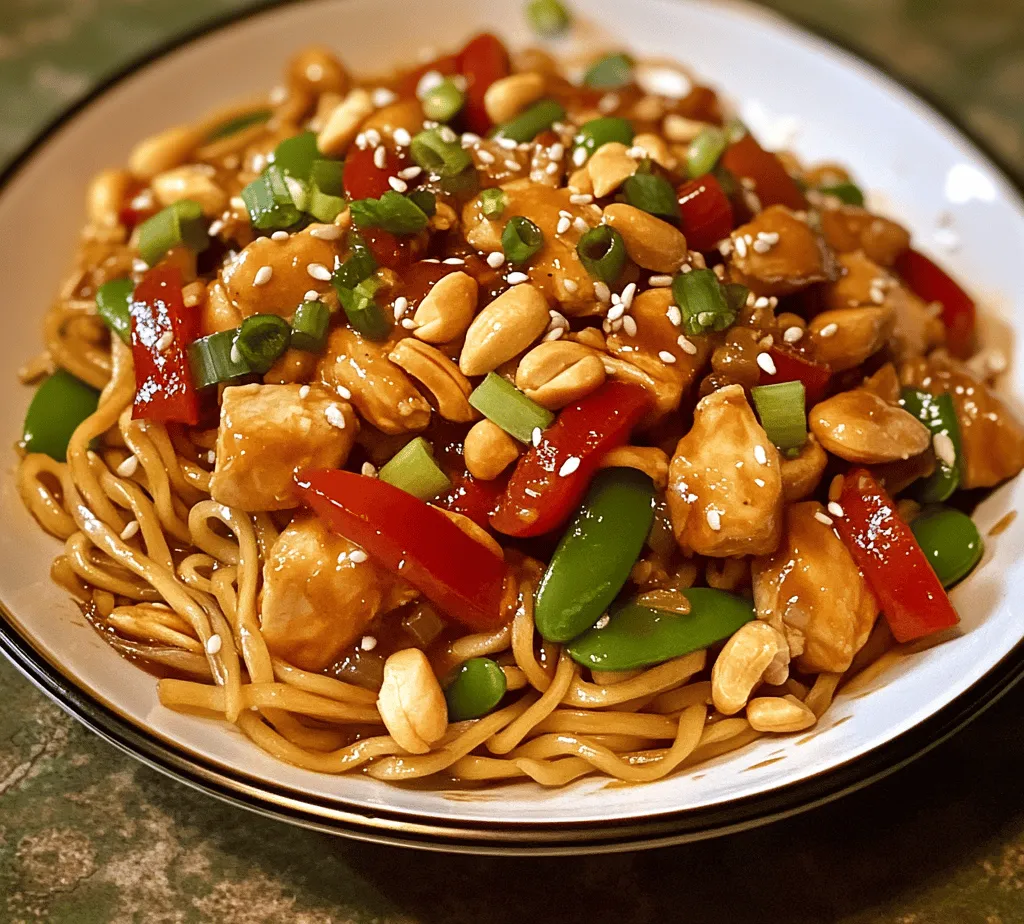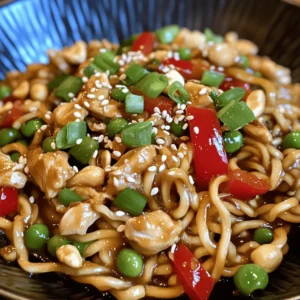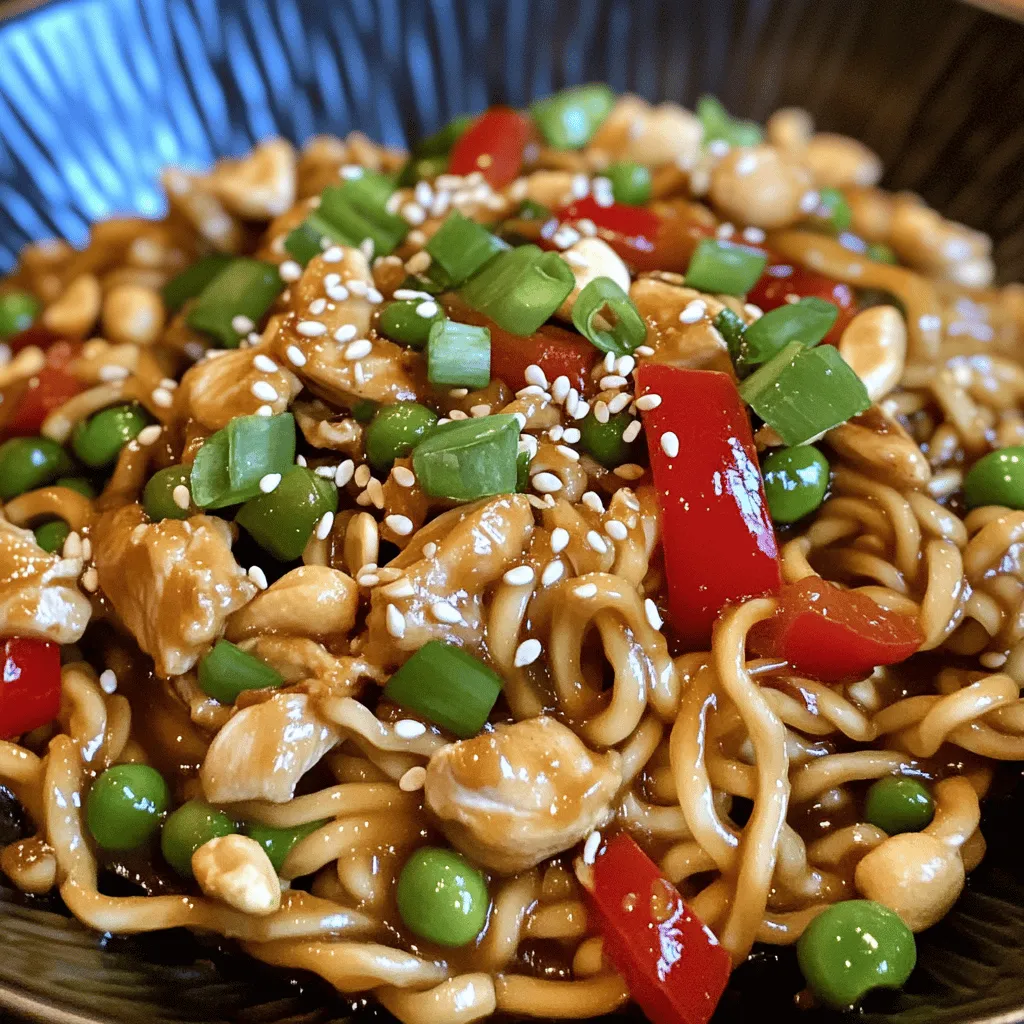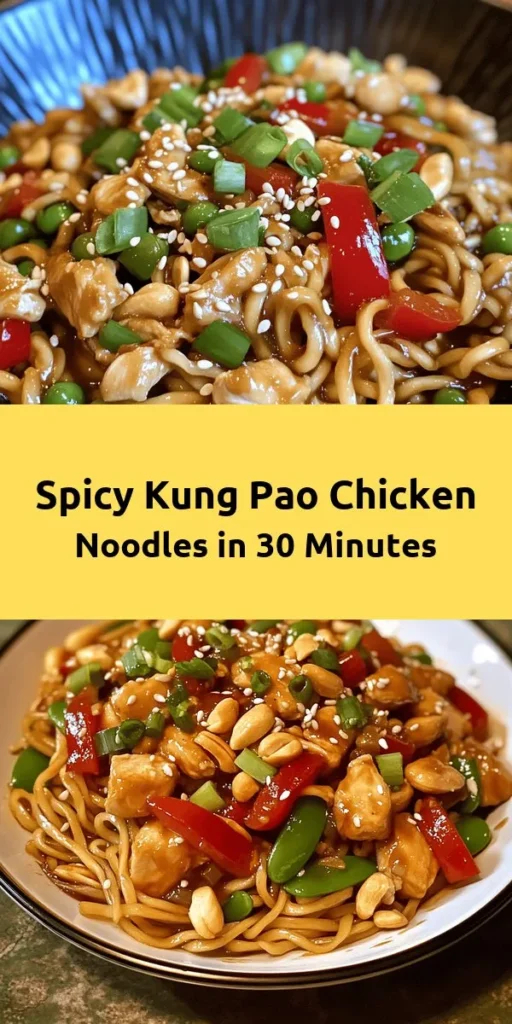Kung Pao Chicken Noodles is a delightful fusion dish that brings together the bold flavors of traditional Kung Pao chicken with the comforting texture of egg noodles. This vibrant recipe is not only a feast for the eyes but also a deliciously satisfying meal that can be prepared in just 30 minutes. Perfect for busy weeknights or a casual gathering, these noodles offer a quick and easy way to enjoy a taste of Asian cuisine at home. In this article, we will explore the origins of Kung Pao chicken, the key ingredients that make this dish shine, and a step-by-step guide to creating this flavorful meal.
The Origins of Kung Pao Chicken
Kung Pao chicken, known as “Gong Bao Ji Ding” in Mandarin, has its roots in the Sichuan Province of China. This dish is named after Ding Baozhen, a 19th-century governor of Sichuan, whose title was “Gong Bao.” Originally, Kung Pao chicken was a royal court recipe, featuring diced chicken that was stir-fried with a mixture of vegetables and peanuts, all tossed in a spicy, savory sauce. Over the years, the dish evolved from its noble beginnings to become popular among the masses, particularly after the introduction of Chinese cuisine to Western countries.
As the dish traveled beyond China, it underwent several adaptations to cater to local tastes and ingredient availability. In the United States, for example, Kung Pao chicken often features a sweeter sauce and a variety of vegetables that may not be found in the original recipe. Despite these variations, the core elements of Kung Pao chicken—spicy, savory, and nutty—remain intact, allowing this dish to maintain its cultural significance.
Today, Kung Pao chicken is celebrated globally, with many regional interpretations that highlight local flavors and cooking techniques. From its spicy roots in Sichuan to the more subdued flavors found in Western adaptations, Kung Pao chicken continues to be a favorite among food enthusiasts who appreciate its complex taste profile.
Understanding Key Ingredients
To create the perfect plate of Kung Pao Chicken Noodles, understanding the essential ingredients is key. Each component plays a crucial role in developing the dish’s signature flavor and texture.
Egg Noodles
Egg noodles are a staple in many Asian dishes, and they serve as the perfect base for Kung Pao Chicken Noodles. Their slightly chewy texture and ability to absorb flavors make them an ideal partner for the rich sauce. There are various types of egg noodles available, from thin vermicelli to thicker chow mein noodles. For this recipe, medium-width egg noodles work best, as they provide a satisfying bite without overpowering the other ingredients. When cooked correctly, egg noodles can add a comforting element to the dish, making it feel hearty and wholesome.
Chicken Breast
The choice of protein in Kung Pao Chicken Noodles is typically boneless, skinless chicken breast. Marinating the chicken is essential for enhancing its flavor and tenderness. A simple marinade made with soy sauce, cornstarch, and a touch of rice vinegar allows the chicken to soak up the seasoning, resulting in juicy, flavorful bites. It’s important to let the chicken marinate for at least 15 minutes (or longer, if time permits) to allow the flavors to penetrate deeply.
Sauces: Soy Sauce, Rice Vinegar, and Hoisin Sauce
The sauce is what truly brings the dish to life. A balanced sauce typically consists of soy sauce, rice vinegar, and hoisin sauce. Soy sauce provides the umami base, while rice vinegar adds a subtle tang that brightens the overall flavor. Hoisin sauce brings a unique sweetness and depth, offering a perfect counterbalance to the heat from the chili peppers. Together, these three ingredients create a harmonious sauce that coats the noodles and chicken beautifully, ensuring each bite is packed with flavor.
Vegetables
Adding fresh vegetables not only enhances the nutritional value of the dish but also contributes color and crunch. In this recipe, bell peppers and snap peas are the stars. Bell peppers come in various colors—red, yellow, and green—each adding its unique sweetness and visual appeal. Snap peas, on the other hand, provide a satisfying crispness, making them an excellent addition to the dish. Together, these vegetables create a medley of textures that complement the tender chicken and chewy noodles.
Peanuts and Dried Chili Peppers
No Kung Pao dish is complete without the signature crunch of peanuts and the kick from dried chili peppers. Peanuts add a delightful nuttiness and additional texture, making each bite interesting. Depending on your spice tolerance, you can adjust the number of dried chili peppers used in the recipe. They provide not only heat but also a distinct flavor that elevates the dish. When cooked, the chilies release their oils, infusing the dish with warmth and depth.
Preparation Steps for Kung Pao Chicken Noodles
Creating a delicious plate of Kung Pao Chicken Noodles involves several straightforward steps. Here’s a comprehensive guide to preparing this tasty meal.
Cooking the Egg Noodles
Begin by cooking the egg noodles according to the package instructions. Bring a large pot of salted water to a rolling boil and add the noodles. Stir occasionally to prevent clumping, and cook for about 4-6 minutes, or until al dente. It’s crucial not to overcook the noodles, as they will continue to cook slightly when combined with the hot stir-fried ingredients. Once cooked, drain the noodles and rinse them briefly under cold water to stop the cooking process. Toss them with a splash of oil to prevent sticking and set them aside.
Marinating the Chicken
While the noodles are cooking, prepare the chicken by cutting it into bite-sized pieces. In a mixing bowl, combine the chicken with soy sauce, cornstarch, and a dash of rice vinegar. The cornstarch not only helps to flavor the chicken but also creates a protective coating that locks in moisture during cooking. Allow the chicken to marinate for at least 15 minutes. If you have time, marinating for up to an hour in the refrigerator will enhance the flavors even more.
Making the Sauce
While the chicken is marinating, you can prepare the Kung Pao sauce. In a separate bowl, whisk together soy sauce, rice vinegar, hoisin sauce, and a little sugar to balance the flavors. It’s important to taste as you go; you want a sauce that is savory, slightly sweet, and tangy. If you prefer more heat, you can add a sprinkle of red pepper flakes or some additional chopped dried chili peppers to the mix. Set the sauce aside until you’re ready to stir-fry the chicken and vegetables.
With the noodles cooked, chicken marinated, and sauce prepared, you’re ready to combine all the elements and bring this vibrant dish to life. As we move forward in the recipe, the combination of these ingredients will create a satisfying and flavorful meal that captures the essence of Kung Pao chicken while showcasing the delightful texture of egg noodles.

Stir-Frying Techniques: Importance of High Heat and Timing for Optimal Results
When it comes to creating the perfect Kung Pao Chicken Noodles, mastering the art of stir-frying is essential. Stir-frying is a quick cooking method that requires high heat and precise timing. This technique ensures that the ingredients are cooked evenly while retaining their natural flavors and textures.
To achieve the best results, start by preheating your wok or large skillet over high heat. The key is to ensure the pan is hot enough to sear the ingredients, which helps to lock in moisture and flavor. High heat also allows for the characteristic charred flavor that enhances the dish’s overall profile.
Timing is equally crucial; you want to add ingredients in the right sequence to achieve the desired doneness. Aromatics like garlic and ginger should be added first, as they release their essential oils and fragrances quickly. Chicken should follow, cooking until just done, while vegetables should be added last to ensure they remain tender-crisp. By mastering these stir-frying techniques, you’ll create a flavorful and vibrant dish that truly shines.
Cooking Process: Step-by-Step Instructions
Step 1: Stir-Frying the Aromatics
Begin by adding two tablespoons of oil to your preheated wok. A neutral oil with a high smoke point, like canola or peanut oil, is ideal for stir-frying. Once the oil is shimmering, it’s time to introduce your aromatics: one tablespoon of minced garlic and one tablespoon of minced ginger. Stir these ingredients quickly for about 30 seconds, or until fragrant. Be careful not to burn them, as burnt aromatics can impart a bitter taste to your dish.
Step 2: Cooking the Chicken
Next, add the marinated chicken to the wok. Ensure the chicken is spread out in a single layer to allow for even cooking. Cook for about 4-5 minutes, stirring frequently until the chicken is golden brown and fully cooked through. The internal temperature should reach 165°F (75°C) for safety and optimal juiciness. Once cooked, remove the chicken from the wok and set it aside, leaving the flavorful oil and aromatics behind.
Step 3: Incorporating Vegetables
Add an additional tablespoon of oil if needed, and then toss in your vegetables: one cup of diced bell peppers (red and green), one cup of diced zucchini, and half a cup of sliced carrots. Stir-fry the vegetables for about 2-3 minutes, ensuring they remain tender-crisp. The goal is to maintain their vibrant color and crunch, which will contrast beautifully with the soft noodles and chicken.
Step 4: Combining with Noodles
Once the vegetables are cooked to your liking, return the chicken to the wok. Pour in the prepared sauce made from soy sauce, rice vinegar, and chili paste. Stir well to combine. Then, add 8 ounces of cooked noodles (preferably egg noodles or rice noodles) to the mix. Toss everything together, ensuring that the noodles are evenly coated with the sauce and mixed thoroughly with the chicken and vegetables. This step is crucial for achieving a harmonious blend of flavors.
Serving Suggestions and Presentation
Presentation plays a vital role in enhancing your dining experience, especially with a visually appealing dish like Kung Pao Chicken Noodles. Here are some ideas to elevate your plating:
1. Plating: Use a large, shallow bowl to serve your noodles. Start with a base of noodles, then artfully arrange the chicken and vegetables on top. This not only creates height but also showcases the vibrant colors of the ingredients.
2. Garnishing: To finish, sprinkle finely chopped green onions and toasted sesame seeds over the top. The green onions add a fresh crunch, while the sesame seeds introduce a nutty flavor and appealing texture.
3. Side Dishes: Consider serving Kung Pao Chicken Noodles with a side of steamed edamame or a light cucumber salad to balance the meal. For beverages, a chilled Asian lager or a light white wine pairs well, enhancing the flavors of the dish without overpowering them.
Nutritional Benefits of Kung Pao Chicken Noodles
Kung Pao Chicken Noodles not only tantalize your taste buds but also pack a nutritional punch. Here’s a breakdown of the dish’s macronutrient profile:
– Protein: The chicken provides a solid source of lean protein, essential for muscle repair and growth. Depending on the portion size, you can expect about 25 grams of protein per serving.
– Vitamins and Minerals: The colorful array of vegetables contributes important vitamins such as A, C, and K, along with minerals like potassium and magnesium. Each ingredient adds its unique set of nutrients, making this dish a well-rounded meal.
– Healthy Fats: Peanuts not only add crunch but also healthy fats and additional protein. They are a great source of monounsaturated fats, which are beneficial for heart health.
Balancing indulgence with nutrition is crucial, and Kung Pao Chicken Noodles can certainly fit into a healthy diet. By using fresh ingredients and controlling the amount of oil and sodium, you can enjoy this dish without guilt.
Conclusion
In conclusion, Kung Pao Chicken Noodles is a flavorful and satisfying dish that encapsulates the essence of Asian cuisine. With its rich history, diverse ingredients, and straightforward preparation, this recipe is an excellent choice for anyone looking to explore new culinary horizons. Whether you’re a seasoned cook or a beginner, this dish offers a delightful experience that is sure to please your palate and leave you craving more.
Enjoy the vibrant flavors and comforting textures of this homemade meal, and relish in the joy of creating something special in your kitchen. Embrace the stir-frying techniques, experiment with presentation, and savor the nutritional benefits. Kung Pao Chicken Noodles is not just a meal; it’s a culinary adventure waiting to unfold on your dinner table.



